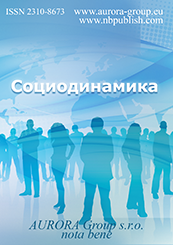Questions of current interest
Reference:
Ursul, A.D. (2015). Russia in BRICS: the Concept of Sustainable Development. Sociodynamics, 5, 1–69. https://doi.org/10.7256/2409-7144.2015.5.15266
Abstract:
In his article Ursul stresses out that the global summits on sustainable development took place in Rio de Janeiro and Johannesburg which is the evidence that BRICS acknowledge the importance of the implementation of a new strategy of civilization development. The implementation of the concept of sustainable development is what in many ways connects BRICS, however, this collective activity of the aforesaid countries have been scarcely mentioned in the academic literature. Sustainable development is viewed as the global strategy to solve the main socionatural contradiction between the growing needs of human and the inability of the biosphere to satisfy these needs. The researcher shows that the Russian Fedeation has already started to conduct the successive transition to the sustainable development. This transition guarantees a balanced solution of socio-economic tasks, environmental and natural-resources potential issues and satisfaction of needs of the present and future generations. However, today's definition of this kind of development differs from what it was initially. Today this concept is broader and based on the systems approach. The author focuses on the need to extend the scope of the concept of sustainable development so that it would include the most areas of human activity. The author suggests that in broader terms sustainable development should mean a secure type of evolution oriented at preservation of civilization and biosphere, their co-existence and co-evolution. Special attention is paid to the relationship between security and development as well as the guarantees of the main forms of security by the means of sustainable development. In his article Ursul has mostly used the futurological predictivem, noospheric and other methodological approaches to futures studies as well as the comparative, evolutionary historical and interdisciplinary scientific approaches. In his research Ursul describes the main contents, peculiarities and prospects for Russia's transfer to the sustainable future which would be oriented at creation of the global noosphere. The author's idea to create the national idea based on the country's secure and sustainable future in a globalized world as it was offered by the author before is also discussed in the present article. To a large extent BRICS is guided by the global strategy of sustainable development. Official documents adopted as a result of the six summits carried out in these major rapidly developing countries are a good proof of that. It is also assumed that BRICS is gradually becoming the leader of the implementation of sustainable development strategy in the global community as a new non-traditional international organization capable of making a great contribution to the preservation of civilization and biosphere and satisfying the need of the humankind to survive.
Keywords:
global sustainability, socionatural contradiction, sustainable development, Russia, national idea, national security, BRICS, global processes, security, environmental security
Questions of current interest
Reference:
Kirko, V.I., Nevzorov, V.N. (2015). Innovative processes in the Siberian Arctic. Sociodynamics, 5, 70–82. https://doi.org/10.7256/2409-7144.2015.5.15325
Abstract:
The given article discloses the peculiarities of innovative processes in the sphere of indigenous small-numbered nations of the Siberian Arctic Region on the territory of the Krasnoyarsk Region (Russia). Conclusions of the article have been done on the basis of wide field researches of 2010-2014 in the Evenkis Municipal Region, Taimyr Dolgano-Nenets Municipal Region, Turukhansk Region, and Tyukhtet Region. The following specialists took part in the field researchers: economists, sociologists, architects, builders, medical specialists, cultural specialists, ethnologists, and fine art experts. The given article is devoted to innovative processes in Surinda - a Northern village (the Evenkis Municipal Region), a compact settlement of Evenkis – an indigenous nation of the Siberian Arctic Region. The main research method used by the authors of the article is the intepretation of the results of field researches conducted in the northern territories of the Krasnoyarsk Region in 2010-2015 and critical analysis of scientific sources on the matter. The basic occupation of Evenkis in Surinda is domestic reindeer breeding, hunting, fishing, and wild plants gathering. The scientists have researched the actual condition of Evenki reindeer breeders, their economic, social and cultural status. In the sphere of the Evenkis, they observe processes of social stratification, single out economic groups of the rich and the poor. Innovative processes should contribute to economic commonwealth of the Evenki reindeer breeders. To achieve this target, the researchers have developed a new typical model of a northern settlement (on the basis of the Surinda village, Evenkia). According to the authors, today's northern settlement should have innovative mini-manufactures that would reduce the cost of consumed energy and food products. The architecture of a northern settlement in Evenkia should involve cultural signs, images and symbols of the Evenki ethnic group. Special features of innovative processes in the sphere of indigenous small-numbered nations of the Siberian Arctic Region include a harmonious combination of cultural and environmental traditions of Evenkis and modern small science-intensive manufactures to provide small ethnic groups living in hazardous climate with all they need for a decent life. Innovative processes in the sphere of indigenous small-numbered nations of the Siberian Arctic Region should contribute to the preservation of the unique cultural, environmental and economic practice of these nations.
Keywords:
traditional society, globalization, indigenous peoples, innovation, Surinda, Evenkia, Siberia, Arctic, modernization, social structures
The heritage of transformation
Reference:
Synieokyi, O.V. (2015). Transformation of the Phonographic Heritage in AudioVisual Culture of Eastern Europe: The Polish Rock and The Sociodynamics of the Sound Recording System . Sociodynamics, 5, 83–113. https://doi.org/10.7256/2409-7144.2015.5.14647
Abstract:
The object of study is a musical recording as a system of socio-cultural communications. The subject of this publication is the history of Polish rock as sociodynamic factor in the transformation of the cultural heritage of the national sound recording system. Cultural heritage in the field of audiovisual culture Phonographic subsystem regarded by the author as an open system of socio-cultural communications. From the standpoint of the development of socio-cultural communication in the music industry authors analyzed the history of the Polish system of record. The article c position in the context of socio-cultural dynamics recording features is presented analysis of formation and development of beat-, pop- and rock-music in Poland. Showing mechanisms of self-organization and self-development of cultural heritage in the field of musical recordings. Problems of studying the history of Polish beat-, pop and rock music in artefacts record considered in conjunction various interpretations. The author conducts scientific research, based on the most significant ideas belonging to different areas of modern humanities, where the priority appears comparative historical methodology. The methodological basis of this publication became classics of the theory of cultural urological thought and modern thinkers. The author concludes that actually rock music became the unofficial center of the special social and communication system around which under socialism in Poland (as well as in other countries from «Eastern Bloc») formed heterogeneous youth subcultures. The process is as a result of scientific and technical modernization of everyday culture of big cities was further deterministic increased access to foreign music. For the recording system of the Polish People's Republic under socialism was an attempt to create an organization of multi-vector of the phonographic industry («Polskie Nagrania – Muza», «Polton», «Savitor», «Arston», «Pronit», «Tonpress», «Veriton», «Wifon»). In conclusion, the author focuses on the fact that the global recording industry at the present stage of development of digital technologies requires upgrading communications platform and cross-cultural communication.
Keywords:
Sound Recording Communications, Record Company, Label, Gramophone Record, Phonographic Culture, Rock Group, Beat Music, Poland, East Europe, Socialist Bloc
Anthropology and ethnogenesis
Reference:
Kicheeva, K.A., Starko, E.A., Reznikova, K.V. (2015). Political and Legal Framework of Cultural Interactions Between Northern Peoples of the Russian Federation: Past and Present. Sociodynamics, 5, 114–122. https://doi.org/10.7256/2409-7144.2015.5.15320
Abstract:
The subject of the research is the sphere of social communication of the northern indigenous peoples living in the regions of the Russian Federation. Particular attention is paid to the state guarantees of the rights of indigenous peoples of the North, Siberia and Far East to have their own unique cultural heritage. The authors of the article focus on the basic contradiction of social and cultural dynamics of indigenous peoples: on the one hand, these ethno-cultural groups have to adapt to the social environment of the post-industrial era, on the other hand, their cultural identity is based on the practices typical for the traditional economy and traditional society. The main research methods used by the authors of the article include the critical analysis of the scientific research literature, processing of results of the field researches carried out in the territories of compact settlement of indigenous communities in the Krasnoyarsk Region and analysis of legal documents regulating preservation of the cultural heritage of the indigenous peoples of the Russian Federation. In the present legislative situation the purpose to 'preserve the traditional lifestyle' loses its meaning as an inherent value at the first attempt of verification because requirements set by modern living conditions for man are in conflict with the traditional style of life. This makes the northern ethnic groups to choose between common law oriented at traditional government institutions and public law under the pressure of the Russian Federation. Thus, at the present time we have the conflict between traditional culture and contemporary or Russian national or global culture. According to the authors, this conflict should be solved by the means of cultural technology rather than economic mechanisms.
Keywords:
traditional society, globalization, right, northern territories, law, cultural heritage, social dynamics, indigenous peoples, resources, acculturation
Politicical behavior
Reference:
Ippolitov, V.A. (2015). Komsomol Members in Grain Procurement Campaign of 1930. Sociodynamics, 5, 123–138. https://doi.org/10.7256/2409-7144.2015.5.15312
Abstract:
In the present article the role of the Komsomol organizations in carrying out the grain procurement campaign of 1930 is investigated. The author considers Komsomol as a sociocultural phenomenon, reveals factors of its versatile influence on the society and tries to summarize both positive and negative experience in that sphere. The author focuses on participation of young people in compulsory withdrawal of bread from peasants. Based on the case study of the Central Black Earth Oblast (CBEO) the contradictory attitude of Komsomol members to procuring policy of the state is shown. Special attention is paid to cases of performances and speeches of Komsomol members against grain collection. Evolution of the mechanism of grain collection is also traced. Objectivity of the author's approach was shown in his aspiration to overcome ideological stereotypes both in studying the social and economic situation and Komsomol, in his search for methods of historiographic analysis allowing to overcome biased submission of information in official documents. As a result of the research the author comes to a conclusion that the compelled participation of Komsomol members in grain procurement campaign created the opposition between them and other people living in the village. The party used the All-Union Leninist Young Communist League to perform political campaigns and thus putting young people in line of fire. Passive behavior of young people in carrying out this campaign was the most widespread form of resistance to the plunderous policy.
Keywords:
peasantry, right bias, history, prosperous peasant, communist party, collectivization, youth, grain-collection, Komsomol, sociocultural phenomenon
 This work is licensed under a Creative Commons Attribution-NonCommercial 4.0 International License.
This work is licensed under a Creative Commons Attribution-NonCommercial 4.0 International License.
 Eng
Eng











 © 1998 – 2025 Nota Bene. Publishing Technologies. NB-Media Ltd.
© 1998 – 2025 Nota Bene. Publishing Technologies. NB-Media Ltd.




